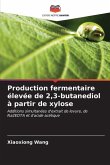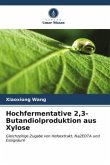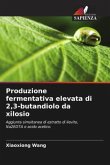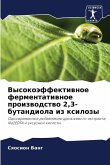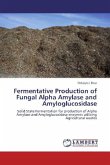The effective use of xylose may significantly enhance the feasibility of using lignocellulosic hydrolysate to produce 2,3-butanediol (2,3-BD). Previous difficulties in 2,3-BD production include that the high-concentration xylose cannot be converted completely and the fermentation rate is slow. This study investigated the effects of yeast extract, Na2EDTA, and acetic acid on 2,3-BD production from xylose. It was found that simultaneous addition of these three components could significantly improve 2,3-BD production. The optimal concentrations of yeast extract, Na2EDTA, and acetic acid were 35.2, 1.2, and 4.5 g/L, respectively. The 2,3-BD concentration in the optimized medium reached 39.7 g/L after 48 h of shake flask fermentation. The xylose utilization ratio and the 2,3-BD concentration increased to 99.0% and 42.7 g/L, respectively, after 48 h of stirred batch fermentation. Furthermore, the 2,3-BD yield was 0.475 g/g, 95.0% of the theoretical maximum value. As the major components of lignocellulosic hydrolysate are glucose, xylose, and acetic acid, the results of this study indicate the possibility of directly using the hydrolysate to effectively produce 2,3-BD.
Bitte wählen Sie Ihr Anliegen aus.
Rechnungen
Retourenschein anfordern
Bestellstatus
Storno


